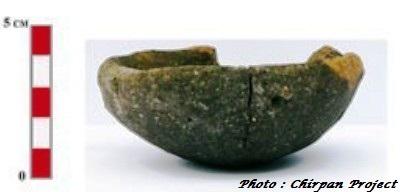Archaeological amazements from Bulgaria : 5 thousands-year-old burials (Chirpan project)
Lolita Nikolova
Source : http://www.examiner.com/world-culture-in-national/archaeological-amazements-from-bulgaria-5-thousands-year-old-burials-chirpan-project
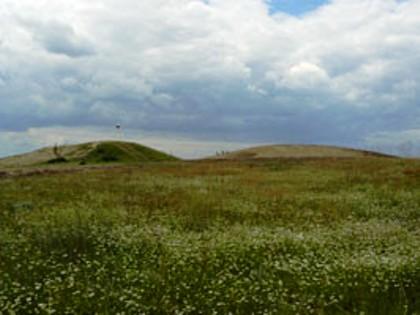
Malkata Momina Mogila and its surrounding environment, Chirpan, South Bulgaria. Photo: Chirpan project
Bulgaria is one of the archaeologically richest countries in the world. Archaeology is a highly prestige profession there with huge media interest in everything what has been discovered. Recently, thanks especially to young generations archaeologists, more information has begun to be published online. An excellent example is 2009-2010 Project "Archaeologiacal examination of a Thracian-Roman Dynasty Centre in the region of the Chirpan Eminences" directed by Dr Milena Tonkova with team.
Among the new discoveries within this project is the Early Bronze Tumulus Malkata Momina Mogila near Chirpan in South Bulgaria, Bratya Daskalovi municipality. Sadly, but significantly for science, several children’s burials were unearthed in this Tumulus (single and a group burial) together with two adolescents, two adults and a baby. If it was a family tumulus that can be proved eventually by a DNA analysis, then, we may face a case of malnutrition and possible virus cause of the death. By all circumstances, the Tumulus is a significant contribution to Balkan later prehistory since the prehistoric burial customs in the Southeast Balkans are still not well known. Luckily, the archaeologists-prehistorians from this part did not violate the ethical norms by purposeful searching of cemeteries, similarly to treasure-hunters, and the data come from rescue excavations. Most wonderfully, the excavators of Malkata Momina Mogila have provided immediately data from physical anthropologist Nadezhda Timeva that is a sign of a special care of the ancient bone. The tumulus was restored to the previous form after the excavation. It will be most satisfying if in future the skeletons will be also returned to their burial place after the analysis.
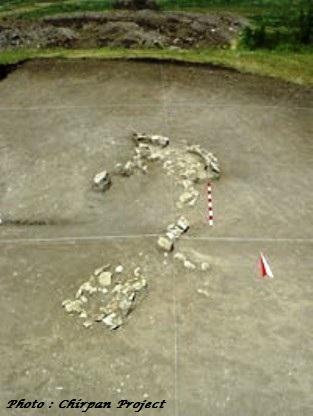
Malkata Momina Mogila
Tumulus Malkata Momina Mogila was erected over a small natural hill, 25 m in diameter and 1.5 m preserved height. Treasure-hunters ditches were documented in the center of the Tumulus. Six single graves and one group grave of four individuals were unearthed together with a ritual pit, stone circle and stone arched-shaped features.
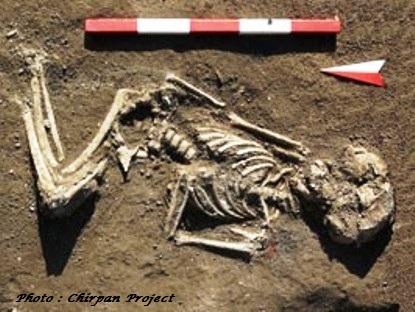
According to the preliminary information, the typical burial ritual was inhumation on back with crouched legs that had fallen to left or right. Red ochre and a ceramic bowl connect the Tumulus with Pit Grave Culture, although there are also analogies in the Bereket cemetery from Early Bronze I that belonged to early Ezero culture (Northeast Thrace). There were graves without pits in this Tumulus.

The Balkans and Early Bronze Age genesis
The Tumulus of Malkata Momina Mogila probably belongs to Early Bronze I as terminus post quem for all EB graves in light of recent evidence. Theoretically, it can even pre-date Ezero tell showing the mechanism of formation of Ezero culture which is still not well documented archaeologically. Two main interpretation models exist:
1. Invasion model that simplifies the cultural process and explain the genesis of Balkan Early Bronze Age Cultures with invasion of population from the Russian steppes (M. Gimbutas and her followers). Gimbutas’ model was based on wrong chronology of Cotofeni culture, and theoretical presumption without specific evidence in the archaeological records by ignoring the whole richness of the Balkan Early Bronze Age cultures. Her followers neither added serious arguments nor even critically analyzed Gimbutas’ thesis, reproducing her opinion often like their own.
2. The genesis of the Early Bronze Age cultures in the Balkans was a long process (c. 3600 – 3000 cal BCE) defined as Early Bronze I (Nikolova, 1999). Mobile and semi-mobile groups participated in this process genetically related to Final Copper Age in the Balkans, as well as groups of mobile population coming from Russian Steppe, but also possibly from Anatolia and Central Europe. This was a process of graduate sedentarization of the mobile stockbreeders resulted in Cernavoda III, Cotofeni, Ezero, Yunatsite, Sitagroi – Dikili Tash, Pernik and other cultures and creating steady ethnograhic zones for a whole year or seasonal pastoralism documented by the burial mounds of the Balkan Pit Grave Culture (the so-called burials with ochre).
The Balkans in Early Bronze I was connected with Anatolia, the Aegean, the North Pontic and Central Europe. Comparing Yunatsite 17-15, Ezero A1 and Cotofeni I together with the early monuments of Pit Grave Culture clearly show a heterogynous cultures and population with different traditions. It is especially important to mention the difference between Yunatsite 17-15 and Ezero 13-11 in the burial rites – missing babies’ graves at Ezero, while such burials typify early Yunatsite cultural pattern. Babies’ burials are not characteristic of the Baden Culture (Central Europe) and this is very important fact in light of attempts of some authors to propose a migration of Central European population to the Balkans, in particular to Upper Thrace, as a Renaissance of the old Indo-Germanic theory rejected by science.
Regarding Northeast Thracian burial mounds of PGC type, there are several explanations, possibly complimentary, models:
1. The Pit Grave Culture were one of the components of the Ezero Culture in process of its sedentarization in later fourth millennium cal BCE.
2. The Pit Grave Culture seasonally come to the area of Ezero Culture in their nomad winter cycle and lived separately from Ezero culture.
3. The Pit Grave Culture integrated with Ezero culture through marriages, economic exchange and temporary permanent sedentarization of whole families or only part of households.
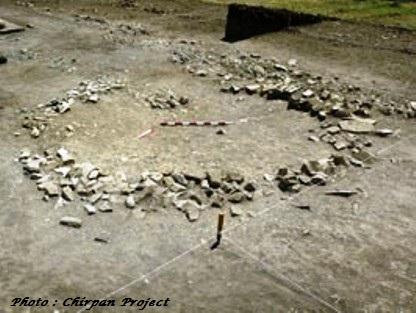
Health in prehistory
Studying the burial rituals help to learn more about the mechanism of cultural process in fourth millennium cal BCE. To the best of my knowledge, all excavations of burials in Upper Thrace (in contrast to Durankulak cemetery) are rescue excavations, respectively in accordance with the ethical standards of global archaeology. It is very positive the fact, that the team of Malkata Momina Mogila has prompt data from physical anthropologist that provide important data about the age of the buried population – four children between 2-7, two males at age 14-15, one adult at 30-40, one matures at 40-50, a child at 2.5-3.5 and a baby. Six of the individuals, including the small child at 2.5-3.5 and the baby were a group primary burial in a pit.
The huge number of children’s in combination with the group burial poses the question of health status of Early Bronze I population in Northeast Thrace. Possible explanation is malnutrition in combination with virus disease. Most likely, the cause was not poison, since the babies do not eat the food of the adults. Unfortunately, the osteological material cannot provide evidence about all possible causes of the death of the prehistoric population. If Malkata Momina Mogila was a household burial mound, then, it can be expected that the household lived on the edge of poverty that may fit more a farming instead pastoral model. It will be really interesting eventual DNA research because of the variety of the rituals reported by the excavators.
